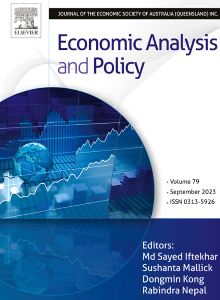气候风险是如何与中国新能源汽车的崛起交织在一起的?
IF 8.7
2区 经济学
Q1 ECONOMICS
引用次数: 0
摘要
探索气候风险与新能源汽车之间的复杂关系,对于促进中国的能源安全和可持续发展至关重要。为了量化气候物理风险指数(PRI)、转型风险指数(TRI)与新能源汽车销量之间的动态相关性,本研究采用随机波动的时变参数向量自回归模型,引入油价作为控制变量。定量分析表明,PRI对新能源汽车的影响为负,表明PRI降低了中国的新能源汽车。相比之下,TRI对新能源汽车有积极的影响,表明TRI可能会增加新能源汽车。相反,新能源汽车对PRI既有正面影响,也有负面影响,表明减缓PRI面临的挑战和机遇。虽然新能源汽车普遍提高了TRI,但PRI在2019-2020年期间有所下降。此外,虽然PRI对TRI有积极影响,但它先增加PRI,然后反转。随着全球气候变化的加剧,本研究为当局在推动新能源汽车的同时解决PRI和促进能源安全提供了有价值的见解。本文章由计算机程序翻译,如有差异,请以英文原文为准。
How do climate risks intersect with the rise of new energy vehicles in China?
Exploring the complex relationships between climate risk and new energy vehicles is vital to advancing energy security and sustainable development in China. To quantify the dynamic correlations between the climate physical risk index (PRI), the transition risk index (TRI) and the sale of new energy vehicle (NEV), this study employs the time-varying parameter vector autoregression model with stochastic volatility, introducing oil price as a control variable. The quantitative analyses demonstrate that PRI has a negative effect on NEV, indicating that PRI decreases NEV in China. In contrast, TRI has a positive effect on NEV, indicating that TRI might increase NEV. Conversely, NEV positively and negatively impacts PRI, indicating challenges and opportunities in PRI mitigation. While NEV generally elevated TRI, PRI decreased during 2019–2020. Moreover, while PRI has a positive effect on TRI, it initially increases PRI and then reverses. As climate change intensifies globally, this study offers valuable insights for authorities to simultaneously boost NEV while addressing PRI and promoting energy security.
求助全文
通过发布文献求助,成功后即可免费获取论文全文。
去求助
来源期刊

Economic Analysis and Policy
ECONOMICS-
CiteScore
9.80
自引率
9.20%
发文量
231
审稿时长
93 days
期刊介绍:
Economic Analysis and Policy (established 1970) publishes articles from all branches of economics with a particular focus on research, theoretical and applied, which has strong policy relevance. The journal also publishes survey articles and empirical replications on key policy issues. Authors are expected to highlight the main insights in a non-technical introduction and in the conclusion.
 求助内容:
求助内容: 应助结果提醒方式:
应助结果提醒方式:


